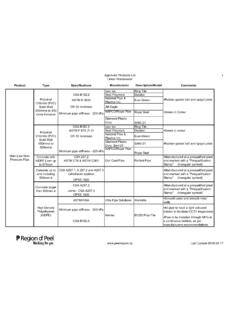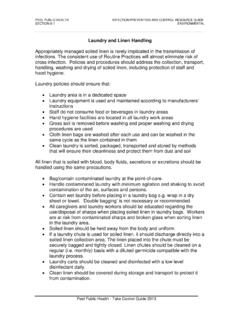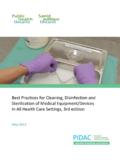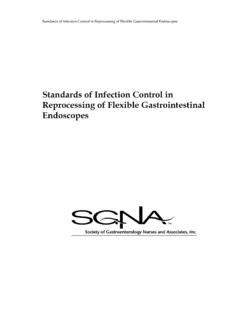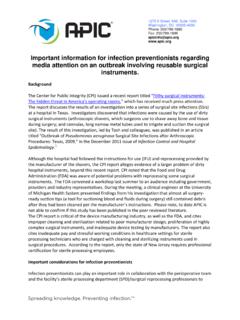Transcription of Cleaning, Disinfection and Sterilization of Medical ...
1 05/04/2013. cleaning , Disinfection and Sterilization of Medical Equipment/Devices in the Community Setting April 11, 2013 Peel Community Infection Prevention and Control Education Day 1. 05/04/2013. Presenter: Risa Cashmore, Infection Prevention and Control Consultant, CWICN (NSMICN). Acknowledgements: Karen Clinker, Infection Prevention and Control Consultant, NWOICN. Reprocessing Project Team, PHO. 2. 2. 05/04/2013. Objectives Describe PIDAC's best practice guideline for reprocessing Define Spaulding's classification Define reprocessing and associated terms Describe the steps required for reprocessing Briefly describe scenarios related to reprocessing Describe resources and reprocessing education 3. 3. 05/04/2013. Best Practice Guideline - PIDAC. Best Practices For cleaning , Disinfection and Sterilization in All Health Care Settings was developed by the Provincial Infectious Diseases Advisory Committee (PIDAC).
2 PIDAC is a multidisciplinary scientific advisory body that provides evidence- based advice to the Chief Medical Officer of Health regarding multiple aspects of infectious disease identification, prevention and control.. The document can be accessed at knowledge/. 4. 4. 05/04/2013. Updates in February 2010. Incorporate revisions from updated Canadian standards : CSA Effective Sterilization in Health Care Facilities by the Steam Process CSA Effective Sterilization in Health Care Facilities by the Ethylene Oxide Process CSA Decontamination of Reusable Medical Devices (updated available for comment). Includes new information from the Centers for Disease Control and Prevention's Guideline for Disinfection and Sterilization in Healthcare Facilities', published in 2008. NEW: CSA - Chemical Sterilization of reusable Medical devices and others 5. 5. 05/04/2013. References to consider: PIDAC cleaning , Disinfection and Sterilization 2010.
3 Infection Prevention and Control in Clinical Office 2013. Practice Health Canada Infection Prevention and Control Guideline for Flexible 2011. Gastrointestinal Endoscopy and Flexible Bronchoscopy CDC Guideline for Disinfection and Sterilization in healthcare 2008. facilities American Society for Multisociety guideline on reprocessing flexible 2011. Gastrointestinal gastrointestinal endoscopes: 2011. Endoscopy CCAR Best Practices for Long Term Care, Home and Community 2007. Care including Health Care Offices and Ambulatory Clinics Ontario RCDSO Infection Prevention and Control in the Dental Office 2009. 6. 6. 05/04/2013. Reprocessing The steps performed to prepare used Medical equipment/devices for use ( cleaning , Disinfection , Sterilization ).. (CSA, 2009 as referenced in PIDAC, 2010, pg. 9). 7. 7. 05/04/2013. Spaulding's Classification 8. 8. 05/04/2013. Think about all the Medical equipment/devices you use in your health care setting.
4 What kinds of Medical equipment/devices do you use in your health care setting? 9. 9. 05/04/2013. Assessment related to reprocessing Single use/disposable or multi-use? How is it going to be used/How has it been used? Who owns cleaning it? Disinfecting or sterilizing? How do you know it is clean/disinfected/sterile? Do I have manufacturer's directions for reprocessing? Do I have the right products/tools/space? Is your equipment assessed for its ability to be cleaned/disinfected/sterilized prior to purchase? Do I know what I am doing? 10. 10. 05/04/2013. Examples of multi-use items Item Level of Reprocessing reprocessing required Blood pressure cuff, stethoscope, LLD (non-critical) wipe . oximeters , accelerated hydrogen peroxide (5 minutes). Fingernail care equipment used on HLD (semi-critical) , 7% accelerated multiple clients/patients/residents hydrogen peroxide (20 minutes). Foot care Sterilization Steam autoclave or (critical) cold chemical Sterilization *.
5 11. 11. 05/04/2013. PIDAC Appendix A: Reprocessing Decision Chart Manufacturer's recommendations for product, concentration and exposure time must be followed Level of reprocessing ( cleaning vs. LLD vs. HLD vs. Sterilization ). Classification of equipment/device Example of equipment/devices Products 02%20BP%20 cleaning %20 Disinfection % 12. 12. 05/04/2013. COMMUNITY SETTINGS. 13. 13. 05/04/2013. PIDAC and Home Care 14. 14. 05/04/2013. PIDAC and Home Care 15. 15. 05/04/2013. PIDAC and Home Care 16. 16. 05/04/2013. CHICA-Canada Position Statement and Practice Recommendations cleaning and Disinfection of Non-critical Multi-Use Equipment/Devices in Community Settings 17. 17. 05/04/2013. Background Multi-use equipment and Medical devices in health care have been linked to an increased infection risk. The practice of cleaning and disinfecting non-critical equipment in the community between clients, or even on a regular basis, has not been well Outbreaks related to lapses in infection control procedures have been associated with physician offices and.
6 18. 18. 05/04/2013. Position Statement Each community health care organization has the responsibility to identify non-critical equipment used in the delivery of care and to ascertain the appropriate cleaning and Disinfection method and frequency. Written policies and procedures need to be in place and reviewed annually. Multi-use equipment should not be purchased until it is confirmed that it can be reprocessed using established modes and products. As well, audits of cleaning and Disinfection practices and the implementation of a quality improvement process related to the audit results are important. It is essential to reprocess non-critical multi-use equipment and devices appropriately, safely and consistently using an approved hospital-grade' low- level disinfectant which must have a Health Canada Drug Information Number (DIN). 4,5,6,7,8,9,10 . 19. 19. 05/04/2013. Practice Recommendations Hand hygiene as per Routine Practices cleaning and low-level Disinfection Spaulding's Clean when visibly soiled (immediately), after direct contact with a client, after each use (prior to another client), after storage in a client's home 2 step process Risk assessment re frequency Document and communicate Written policies and procedures Audits hospital-grade (DIN number).
7 20. 20. 05/04/2013. Practice Recommendations - continued Materials and design of multi-use equipment Watch for evidence of damage , toys, upholstered items Non-cleanable equipment can't be multi-use Consider disposable items, covers Equipment in the home Limit amount Dedicate equipment Transport of contaminated equipment Contracted equipment 21. 21. 05/04/2013. Practice Recommendations - continued Equipment bag Place on a clean, dry surface Hand hygiene Clean and disinfect on a regular basis and when grossly soiled Document Ambulatory Clinics and Outreach settings Storage cupboards Stretchers and tables Contracted equipment Documentation of cleaning and Disinfection Clean vs. dirty (identify). 22. 22. 05/04/2013. THE BASICS. 23. 23. 05/04/2013. Multi-use equipment All multi-use equipment must be cleaned and disinfected after each use Correct disinfectant Correct dilution Correct contact time Allow to air dry 24.
8 05/04/2013. cleaning cleaning is always essential prior to Disinfection or Sterilization . An item that has not been cleaned cannot be assuredly disinfected or sterilized.. Health Canada. Hand Washing, cleaning , Disinfection and Sterilization . CCDR. 1998; 24S8. 25. 05/04/2013. Q: Why do we need to clean? A: - To physically remove contaminants - If an item is not cleaned, soil ( , blood, body fluids, dirt) can protect the microorganisms from the action of the Disinfection or Sterilization process ineffective. - It also inactivates the disinfectant or sterilant doesn't work! - Disinfectants overloaded with soil can become contaminated source for transmission of microorganisms 26. 05/04/2013. Disinfection Failure to use Disinfection products or processes appropriately has repeatedly been associated with the transmission of healthcare associated infections . Health Canada. Hand Washing, cleaning , Disinfection and Sterilization .
9 CCDR. 1998; 24S8. 27. 05/04/2013. Disinfection All disinfectants must have a Drug Identification Number (DIN). from Health Canada (Public Health Agency of Canada)(Therapeutic Drugs Directorate). Link to learn more about DIN numbers : 28. 05/04/2013. Compatibility Chemicals must be compatible with product Cleaners and disinfectants must be compatible Follow manufacturer's directions Log/document 29. 05/04/2013. REPROCESSING STEPS. 30. 30. 05/04/2013. Step 1: Pre Clean Policies and procedures for all reprocessing steps Remove visible soil at point of use Soak/pre-treat with enzymatic cleaner in approved container/. transport device Image source: Just In Time Productions 31. 31. 05/04/2013. Step 2: Inspection, Disassembly, Sorting and Soaking Disassemble and inspect instrument as required Sort instruments in sets Soak in approved enzymatic cleaner Image source: Just In Time Productions 32.
10 32. 05/04/2013. Step 3: cleaning : Manual or Mechanical Manually clean instrument Clean lumens with brush/cloth Flush Rinse Inspect instrument Follow with mechanical cleaning if available (ultrasonic cleaner). Image source: Just In Time Productions 33. 33. 05/04/2013. Step 4: Rinsing and Drying Rinse with sterile water Air dry or with lint-free towel or compressed filtered air for lumens Image source: Just In Time Productions 34. 34. 05/04/2013. Step 5: High level Disinfection or Chemical Sterilization High Level Disinfection : Soak in approved and properly mixed HLD or chemo sterilant Monitoring, auditing and documentation required Rinse with sterile water x 3 and dry Recall procedure for Sterilization failure Image source: Just In Time Productions 35. 35. 05/04/2013. Step 5: High level Disinfection or Chemical Sterilization Image Source: CHICA Audit Tool Annex J. page 1 36. 36. 05/04/2013.




